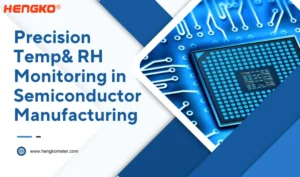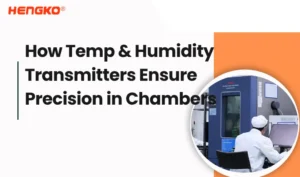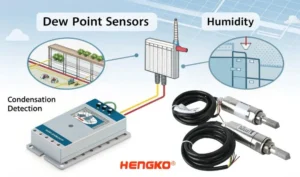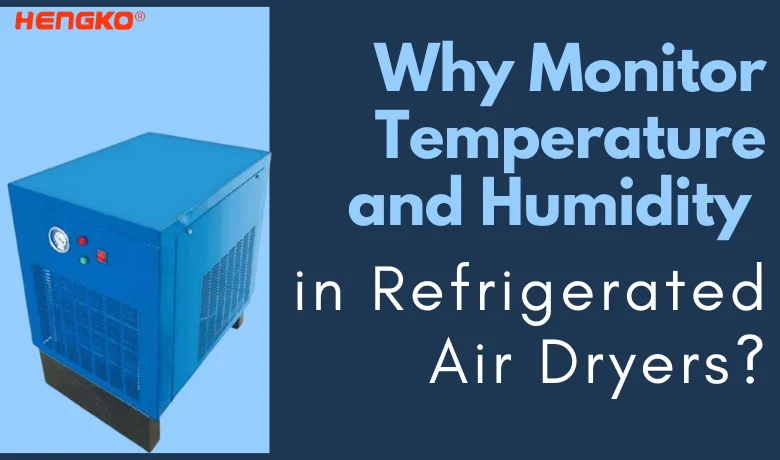
Perché una zona dell'ufficio è troppo umida e come un trasmettitore di umidità la risolve?
Why One Office Zone is Too Humid & How a Humidity Transmitter Fixes It Persistent
Un partner OEM affidabile per il monitoraggio del punto di rugiada nei sistemi di aria compressa, gas e asciugatura
Casa " Misuratore del punto di rugiada
Progettata per garantire precisione e durata, la serie HENGKO HG970 offre una soluzione affidabile per il monitoraggio del punto di rugiada negli ambienti industriali più esigenti. Grazie all'elevata precisione, ai tempi di risposta rapidi e alla robusta struttura in acciaio inox, l'HG970 è ideale per la misurazione continua online nei sistemi di aria compressa, nelle linee di essiccazione dei gas e nei processi produttivi sensibili all'umidità. Sia che abbiate bisogno di un'uscita analogica o digitale, la serie HG970 garantisce prestazioni stabili e una perfetta integrazione nei vostri sistemi di controllo.
Guida alla scelta del misuratore di punto di rugiada/temperatura-umidità serie HG970
| Modello | Intervallo di temperatura | Campi di misura (umidità / punto di rugiada / bulbo umido) | Precisione (temperatura / RH / punto di rugiada) | Tipo di sonda | Applicazione | Caratteristiche / Note |
| HG970 | -30 ~ 80℃ | Intervallo di umidità: 0 ~ 100%RH / Punto di rugiada: -30 ~ 80°C Td / Bulbo umido: 0 ~ 60°C WB | ±0,1℃ / ±1,5%RH / ±3°C Td | Sonda sostituibile | Monitoraggio generico di sistemi HVAC, laboratori e ambienti industriali | Modello standard con sonda facile da sostituire per la manutenzione periodica |
| HG972 | -30 ~ 80℃ | Intervallo di umidità: 0 ~ 100%RH / Punto di rugiada: -30 ~ 80°C Td / Bulbo umido: 0 ~ 60°C WB | ±0,1℃ / ±1,5%RH / ±3°C Td | Sonda rotonda | Sistemi compatti come camere di prova ambientali, armadi di stoccaggio o piccole centraline di controllo | Sonda rotonda salvaspazio per installazioni strette |
| HG984 | -30 ~ 80℃ | Intervallo di umidità: 0 ~ 100%RH / Punto di rugiada: -30 ~ 80°C Td / Bulbo umido: 0 ~ 60°C WB | ±0,1℃ / ±1,5%RH / ±3°C Td | Sonda affilata OEM | Integrazione OEM in apparecchiature compatte, gruppi di sensori o pannelli di strumenti | Sonda affilata personalizzata per applicazioni embedded e OEM |
| HG983 | -30 ~ 100℃ | Intervallo di umidità: 0 ~ 100%RH / Punto di rugiada: -30 ~ 80°C Td / Bulbo umido: 0 ~ 60°C WB | ±0,1℃ / ±1,5%RH / ±3°C Td | Sonda lunga e affilata | Condotte dell'aria compressa, forni di essiccazione e ingressi dei serbatoi | Sonda a portata estesa ideale per l'inserimento in condotti o porte profonde |
| HG981 | -30 ~ 120℃ | Intervallo di umidità: 0 ~ 100%RH / Punto di rugiada: -30 ~ 80°C Td / Bulbo umido: 0 ~ 60°C WB | ±0,1℃ / ±1,5%RH / ±3°C Td | Sonda lunga OEM | Sale di essiccazione delle batterie al litio, linee di gas ad alta temperatura del settore petrolchimico | Sonda lunga e resistente per applicazioni gravose e ad alta temperatura |
| HG982 | -30 ~ 120℃ | Intervallo di umidità: 0 ~ 100%RH / Punto di rugiada: -30 ~ 80°C Td / Bulbo umido: 0 ~ 60°C WB | ±0,1℃ / ±1,5%RH / ±3°C Td | Sonda tagliente divisa | Essiccatoi industriali, camere d'aria riscaldate o ambienti di difficile accesso | Design diviso per facilitare l'installazione e il posizionamento della sonda |
Serie HG970
Misuratore portatile del punto di rugiada HG970 - La precisione in tasca
Il misuratore portatile del punto di rugiada è un dispositivo leggero e pronto per l'uso, progettato per una rapida misurazione del punto di rugiada,
misurazioni accurate dell'umidità e del punto di rugiada in un'ampia gamma di ambienti.
*compatto e portatile - Ideale per l'uso mobile nelle ispezioni sul campo e nei siti remoti
*Alta precisione - I sensori avanzati garantiscono letture precise del punto di rugiada
*Applicazioni versatili - Adatto per controlli HVAC, misure industriali puntuali e monitoraggio ambientale
*Risposta rapida - Si adatta rapidamente alle condizioni mutevoli per ottenere risultati in tempo reale
*Interfaccia facile da usare - Comandi semplici e display chiaro per un funzionamento senza sforzo
*Resistente e leggero - Costruito per resistere alle condizioni più difficili sul campo senza ingombri aggiuntivi
*Strumento essenziale - Un must per i professionisti che necessitano di dati affidabili sull'umidità in movimento
HENGKO è leader mondiale nelle soluzioni di sensori industriali, con una reputazione di design unico e prestazioni eccellenti. I nostri trasmettitori e sensori di temperatura e umidità sono utilizzati in un'ampia gamma di settori, tra cui quello alimentare e delle bevande, farmaceutico, manifatturiero e del monitoraggio ambientale.
È possibile personalizzare completamente un prodotto unico di sensore di punto di rugiada basato sulla nostra serie di trasmettitori di punto di rugiada brevettati e autoprogettati.
Otterrete un prezzo molto più basso e competitivo grazie al nostro controllo estremamente conveniente.
Con i nostri prodotti in continuo aggiornamento potrete sempre soddisfare le esigenze del mercato in continua evoluzione.
Avrete un forte supporto di marketing per aiutarvi a vendere i prodotti con successo, il materiale di supporto include: immagini dei prodotti ad alta risoluzione, video ad effetto 3d e molto altro ancora.










Sensore del punto di rugiada per il monitoraggio del sistema di aria compressa: garantisce un controllo ottimale dell'umidità e della qualità dell'aria per la macchina a compressione d'aria.
HENGKO è un produttore affidabile di trasmettitori di punto di rugiada ad alte prestazioni, trasmettitori di temperatura e umidità e misuratori di punto di rugiada portatili.
Siamo specializzati nella fornitura di una gamma completa di soluzioni di monitoraggio personalizzate per soddisfare le esigenze specifiche delle applicazioni industriali e ambientali.
Progettati per garantire precisione, durata e stabilità a lungo termine, i nostri prodotti assicurano prestazioni affidabili in condizioni difficili. Che siate alla ricerca di un preciso sensore del punto di rugiada o di un robusto trasmettitore di umidità, HENGKO offre la tecnologia e l'esperienza necessarie per supportare il vostro progetto.
👉 Contattateci oggi stesso per esplorare soluzioni personalizzate adatte alle vostre sfide di monitoraggio.






A Misuratore del punto di rugiada è uno strumento di precisione utilizzato per misurare la temperatura del punto di rugiada-la temperatura alla quale l'umidità presente nell'aria o nei gas inizia a condensare in acqua liquida. È un parametro fondamentale per comprendere livelli di umidità e contenuto di umidità in varie applicazioni industriali e ambientali.
Misure temperatura del punto di rugiada in °C o °F
Indica saturazione dell'umidità in aria o gas
Aiuta a rilevare contaminazione da umidità in aria compressa, gas o ambienti controllati
Sistemi ad aria compressa (evitare l'accumulo di acqua)
Processi di essiccazione a gas (ad esempio azoto, argon, idrogeno)
Sistemi HVAC (garantire il controllo del clima interno)
Camere asciutte per batterie al litio (ambienti sensibili all'umidità)
Produzione farmaceutica e alimentare (conservazione sensibile all'umidità)
| Tipo | Descrizione |
|---|---|
| Misuratore portatile del punto di rugiada | Handheld, used for spot-checks and field diagnostics |
| Online Dew Point Transmitter | Fixed installation, sends real-time data to control systems (e.g. 4–20 mA, RS485) |
| Mirror-type Hygrometer | Laboratory-grade, ultra-accurate but costly |
Prevents corrosion, condensation, and product defects
Ensures compliance with industry standards (ISO, GMP, etc.)
Enhances energy efficiency and equipment lifespan
Checking the dew point with the HG970 series portable dew point meter from HENGKO is a precise, efficient, and reliable process designed for both industrial field inspections and laboratory-quality measurements. The HG970 series offers various probe configurations to suit a wide range of applications, from general HVAC systems to high-temperature drying environments. Below is a step-by-step guide and technical overview of how the dew point measurement is conducted using this instrument.
The HG970 series includes multiple probe types (e.g., replaceable, sharp, long, split) and temperature ranges (-30°C to 120°C), allowing users to choose the most suitable model based on their measurement environment. For example:
HG970 / HG972: Ideal for general industrial and HVAC applications.
HG981 / HG982: Recommended for high-temperature environments (80–120°C), such as lithium battery drying rooms and gas pipelines.
Ensure the device is powered (via external power supply or field setup).
Connect the probe securely to the test point, pipe port, or environmental chamber.
For accurate results, avoid exposing the sensor to sudden humidity shocks or contaminants like oil or dust before the reading stabilizes.
Once connected, the HG970’s built-in sensing module continuously samples the air or gas, measuring parameters such as:
Dew Point Temperature (°C or °F)
Relative Humidity (%RH)
Ambient Temperature (°C/°F)
These values are calculated using HENGKO’s advanced polymer capacitive or ceramic sensor technology, offering fast response time e high accuracy even in dynamic or high-moisture environments.
If the model includes an LCD or digital interface (optional), the readings are displayed in real-time. For models without a display, the output is transmitted via:
Analog Signal (4–20 mA / 0–10 V)
Digital Communication (RS485 / Modbus-RTU)
These outputs can be logged via a data logger, PLC, or remote monitoring software.

The dew point temperature tells you the exact point at which condensation would occur under current pressure and humidity conditions. Lower dew points indicate drier air, which is critical for:
Preventing corrosion or moisture damage in pneumatic tools or compressed air systems
Maintaining strict humidity control in cleanrooms, dry rooms, or gas drying processes
For example:
Dew point < -40°C: Suitable for high-purity gas systems and lithium battery environments.
Dew point 0 ~ 10°C: Typical in HVAC, food storage, and general industrial applications.
To maintain reliable performance:
Calibrate the device periodically (typically once every 6–12 months) against a traceable standard.
Clean or replace the sensor probe as needed, especially if used in harsh or dusty environments.
Store the unit in a dry and clean place when not in use.
✅ Wide temperature and humidity range
✅ Interchangeable probe options for different environments
✅ Compact and robust construction for field use
✅ High accuracy and fast response time
✅ Optional OEM customization for unique industrial requirements
Contact HENGKO’s technical team at ka@hengko.com or visit www.hengkometer.com to get personalized advice based on your industry, installation method, and measurement conditions.
Il HG970 series dew point transmitters from HENGKO are designed for industrial-grade dew point monitoring with high precision and stability. The normal dew point measurement range of the HG970 series is typically:
-60°C to +60°C Td (typical)
(Custom ranges available upon request)
| Parameter | Dettagli |
|---|---|
| Typical Range | -60°C ~ +60°C dew point (Td) |
| Intervallo di umidità | 0%RH to 100%RH |
| Intervallo di temperatura | -30°C to +120°C (varies by model, e.g., HG970 to HG982) |
| Sensor Type | Polymer capacitive or ceramic sensor (high accuracy, fast response) |
| Segnale di uscita | 4–20mA, 0–5V, 0–10V, RS485 / Modbus-RTU |
| Precisione | ±2°C Td typical (customizable based on sensor class) |
-60°C to -20°C Td: Ideal for compressed air drying systems, lithium battery dry rooms, o gas drying
-20°C to +20°C Td: Common in Sistemi HVAC, pharmaceutical environments, e storage facilities
+20°C to +60°C Td: Suitable for high-moisture process areas, o climate chambers
If you need a customized dew point range, HENGKO can tailor the sensor configuration based on:
Target environment (dry gas, ambient air, high temp zone)
Accuracy requirement
Signal output preferences
📩 Contact: ka@hengko.com to request a custom specification or get technical support.
This is Great question!
Understanding the difference between punto di rugiada e umidità is key to accurately evaluating air moisture content
—especially in industrial, HVAC, and environmental monitoring applications.
| Aspect | Punto di rugiada | Humidity (Relative Humidity, %RH) |
|---|---|---|
| Definizione | Il temperatura at which air becomes fully saturated and water vapor condenses into liquid | Il percentage of water vapor in the air compared to the maximum it can hold at a given temperature |
| Unit | °C or °F (Temperature) | %RH (Percentage) |
| Absolute/Relative? | Absolute measure of moisture content | Relative measure (depends on air temperature) |
| Temperature Dependent? | No – dew point is not affected by ambient temperature | Yes – higher temperatures can hold more moisture, affecting %RH |
| What it tells you | How dry or moist the air actually is | How close the air is to saturation at a given temperature |
| Used for | Precise control in drying, gas purity, industrial process monitoring | General comfort, climate control, environmental monitoring |
| Example | Dew point of -40°C = extremely dry air (used in lithium battery rooms) | 60%RH at 25°C = moderately humid air |
Punto di rugiada = “How much water is really in the air?”
Relative Humidity = “How full is the air’s moisture tank at this temperature?”
| Ambient Temp | Punto di rugiada | Relative Humidity |
|---|---|---|
| 25°C | 10°C | ~45%RH |
| 25°C | 20°C | ~75%RH |
| 25°C | 24°C | ~95%RH |
Utilizzo Punto di rugiada for:
Compressed air drying systems
Inert gas monitoring (N₂, Ar, H₂)
Camere asciutte per batterie al litio
Utilizzo %RH for:
Indoor air quality
HVAC system control
Agricultural storage
Even though the temperature is the same, the dew point increases with more water vapor in the air, which raises the relative humidity.
Both devices are used to measure the dew point temperature, a critical parameter in determining moisture levels in air or gas. However, they differ significantly in design, application, e integration method.
| Aspect | Descrizione |
|---|---|
| Measurement Function | Both measure temperatura del punto di rugiada accurately to detect moisture levels |
| Sensor Technology | Typically use similar capacitive or ceramic humidity sensors |
| Target Media | Both used with air, compressed gases, dry gases, etc. |
| Applicazioni | Found in industrial, HVAC, environmental monitoring, e gas drying |
| Feature / Aspect | Misuratore del punto di rugiada | Trasmettitore di punto di rugiada |
|---|---|---|
| Form Factor | Portable or handheld | Fixed-installation / inline sensor |
| Display | Built-in LCD or digital display | Usually no display (or optional), outputs data to external systems |
| Power Source | Battery-powered or rechargeable | Externally powered (e.g., 24V DC) |
| Segnale di uscita | Internal data logging, USB export (optional) | Analog (4-20 mA, 0-10V) or Digital (RS485/Modbus-RTU) |
| Use Case | On-site spot checks, mobile inspections | Continuous online monitoring & automation systems |
| User Type | Technicians, maintenance staff | Engineers, system integrators, automation specialists |
| Installazione | Handheld use or temporary probe connection | Installed permanently in pipelines, dryers, tanks, etc. |
| Fascia di prezzo | Generally higher due to display and portability features | More cost-effective for long-term embedded use |
| Typical Examples | Vaisala DM70, Michell MDM300, HG970 series | HENGKO HG970, Vaisala DMT143, E+E EE371 |
| Scenario | Recommended Device |
|---|---|
| Field diagnostics and mobile inspections | Misuratore del punto di rugiada |
| Continuous monitoring in a compressed air line | Trasmettitore di punto di rugiada |
| Temporary measurements in different locations | Misuratore del punto di rugiada |
| Integration into control/SCADA systems | Trasmettitore di punto di rugiada |
Dew Point Meters are portable tools designed for manual measurements, great for spot-checking and troubleshooting.
Dew Point Transmitters are installed devices built for long-term, real-time monitoring e system automation.
L'uscita 4-20mA è una scelta popolare per i sensori di punto di rugiada perché è un'uscita industriale standard compatibile con un'ampia gamma di sistemi di controllo. È inoltre un'uscita molto affidabile e resistente al rumore, che la rende adatta all'uso in ambienti industriali difficili.
Ecco alcuni dei vantaggi dell'uso di un'uscita 4-20mA per i sensori di punto di rugiada:
Compatibilità: L'uscita 4-20mA è compatibile con un'ampia gamma di sistemi di controllo, tra cui PLC, DCS e sistemi SCADA. In questo modo è facile integrare i sensori del punto di rugiada nei sistemi di controllo esistenti.
Affidabilità: L'uscita 4-20mA è molto affidabile e non è soggetta a interferenze di rumore. Questo è importante per i sensori di punto di rugiada, spesso utilizzati in ambienti industriali difficili.
Precisione: L'uscita 4-20mA può fornire misure accurate del punto di rugiada. Ciò è importante per le applicazioni che richiedono un controllo preciso del punto di rugiada.
Gamma: L'uscita 4-20mA può coprire un'ampia gamma di valori del punto di rugiada. Questo lo rende adatto a una varietà di applicazioni.
Costo: L'uscita 4-20mA è un'uscita relativamente economica da implementare. Ciò la rende un'opzione conveniente per i sensori del punto di rugiada.
Oltre ai vantaggi sopra elencati, l'uscita 4-20mA è anche un'uscita molto versatile. Può essere utilizzata per trasmettere una serie di altri parametri, come temperatura, pressione e portata. Ciò la rende un'uscita preziosa per un'ampia gamma di applicazioni industriali.
Ecco alcuni esempi di applicazioni in cui i sensori di punto di rugiada con uscita 4-20mA sono comunemente utilizzati:
Sistemi ad aria compressa: I sensori del punto di rugiada sono utilizzati nei sistemi di aria compressa per monitorare e controllare il contenuto di umidità dell'aria. Questo è importante per prevenire la corrosione e altri danni alle apparecchiature.
Sistemi HVAC: I sensori del punto di rugiada sono utilizzati nei sistemi HVAC per controllare i livelli di umidità negli edifici. Questo è importante per il comfort e la salute delle persone.
Processi di essiccazione industriale: I sensori del punto di rugiada sono utilizzati nei processi di essiccazione industriale per monitorare e controllare il contenuto di umidità del prodotto da essiccare. Questo è importante per garantire la qualità del prodotto.
Lavorazione di alimenti e bevande: I sensori del punto di rugiada sono utilizzati nella lavorazione di alimenti e bevande per controllare il contenuto di umidità del prodotto in lavorazione. Questo è importante per garantire la sicurezza e la qualità del prodotto.
Monitoraggio ambientale: I sensori del punto di rugiada sono utilizzati nelle stazioni di monitoraggio ambientale per monitorare le variazioni del contenuto di umidità nell'atmosfera. Queste informazioni possono essere utilizzate per prevedere le condizioni meteorologiche e identificare potenziali problemi ambientali.
Come si vede, i sensori di punto di rugiada con uscita 4-20mA sono uno strumento prezioso per un'ampia gamma di applicazioni industriali. Sono affidabili, precisi e versatili e possono essere facilmente integrati nei sistemi di controllo esistenti.
Il prezzo dei trasmettitori di punto di rugiada può variare a seconda del produttore, delle caratteristiche e dell'accuratezza del trasmettitore. In generale, i trasmettitori di punto di rugiada con una maggiore accuratezza e un maggior numero di funzioni costeranno di più di quelli con una minore accuratezza e un minor numero di funzioni.
In base alle mie ricerche, direi che il prezzo dei trasmettitori del punto di rugiada è generalmente equo. Il costo dei componenti e della manodopera necessari per la produzione dei trasmettitori del punto di rugiada è elevato e le aziende che li producono devono recuperare questi costi per rimanere in attività. Inoltre, i trasmettitori di punto di rugiada sono utilizzati in una serie di applicazioni critiche, quindi è importante che siano affidabili e precisi. Il prezzo elevato dei trasmettitori del punto di rugiada riflette il fatto che si tratta di strumenti di alta qualità di cui ci si può fidare per fornire misure accurate.
Ecco alcuni fattori che possono influenzare il prezzo di un trasmettitore del punto di rugiada:
Ecco una tabella della gamma di prezzi dei trasmettitori di punto di rugiada presenti sul mercato:
| Tipo | Fascia di prezzo |
|---|---|
| Specchio freddo | $2,000 – $10,000 |
| Polimero | $500 – $2,000 |
| Ossido di metallo | $500 – $1,500 |
Come si può notare, la gamma di prezzi dei trasmettitori di punto di rugiada può variare a seconda del tipo di trasmettitore. I trasmettitori di punto di rugiada a specchio refrigerato sono i più costosi, ma anche i più precisi. I trasmettitori di punto di rugiada a polimeri e ossidi metallici sono meno costosi, ma anche meno precisi.
Il prezzo dei trasmettitori di punti di rugiada può variare anche in base alle caratteristiche del trasmettitore. Ad esempio, i trasmettitori di punto di rugiada con registrazione dei dati, setpoint di allarme e funzionalità di accesso remoto hanno in genere un costo maggiore rispetto ai trasmettitori di punto di rugiada con meno funzioni.
Se siete alla ricerca di un trasmettitore del punto di rugiada di alta qualità, vi consiglio di acquistarne uno di un marchio noto che abbia una buona reputazione in termini di qualità e affidabilità. Dovete anche considerare le caratteristiche più importanti per voi e la precisione che vi serve. Se non siete sicuri di quale sia il trasmettitore di punto di rugiada più adatto a voi, vi consiglio di consultare un professionista che possa aiutarvi a prendere una decisione informata.
some questions about Dew Point Meter you like to know
A Misuratore del punto di rugiada è uno strumento di precisione utilizzato per misurare la temperatura del punto di rugiada — the temperature at which air or gas becomes saturated with moisture and water vapor begins to condense into liquid.
It works by sensing the relative humidity and temperature of the environment or gas stream, then calculating the dew point based on the current saturation level. Most modern dew point meters use capacitive or ceramic sensors for real-time measurements, offering high accuracy and stability across a wide range of industrial applications.
Dew point measurement is critical for moisture control, especially in applications where excess humidity can lead to equipment failure, corrosion, product spoilage, or safety risks.
Industries such as compressed air systems, pharmaceuticals, lithium battery manufacturing, semiconductors, e food packaging depend on dew point monitoring to ensure dry environments and gas purity. In compressed air lines, for example, a low dew point prevents water buildup, which could otherwise damage tools and contaminate end products.
Punto di rugiada è il absolute temperature at which air becomes saturated and water vapor condenses, while humidity (usually relative humidity) is a percentage expressing how much moisture the air currently holds compared to its maximum capacity at a given temperature.
In simple terms:
Punto di rugiada tells you how much moisture is actually in the air (in °C or °F).
Relative humidity tells you how close the air is to saturation (in %RH).
Dew point is more accurate for industrial applications, especially when monitoring drying processes or compressed air systems.
In industrial compressed air systems, the target dew point depends on the drying method e application sensitivity:
| Applicazione | Recommended Dew Point |
|---|---|
| Uso industriale generale | -20°C to -40°C |
| Instrumentation or electronics | -40°C to -70°C |
| Medical/Pharma cleanrooms | ≤ -40°C |
| Standard shop air (non-critical) | 0°C to -10°C |
A lower dew point means drier air, which is essential for high-performance or sensitive operations. The dew point meter helps monitor this and ensure system compliance.
Yes. Most dew point meters — including advanced portable models — can be used to measure dew point in a variety of non-corrosive gases, such as nitrogen (N₂), argon (Ar), carbon dioxide (CO₂), e compressed natural gas (CNG).
However, it is important to verify:
Sensor compatibility with the target gas
Pressure rating of the probe or housing
Flow regulation to avoid sensor contamination
Some models, like the HENGKO HG970 series, offer custom probe materials and protective filters for specialized gas monitoring applications.
For most industrial and professional uses, dew point meters should be calibrated every 6 to 12 months, depending on usage frequency, environmental conditions, and accuracy requirements.
Regular calibration:
Ensures data reliability
Maintains regulatory compliance (e.g., ISO, GMP)
Extends the lifespan of the sensor
HENGKO and other manufacturers often offer traceable calibration services and replacement sensors for field units.
Typical high-quality portable dew point meters can measure within a range of:
-80°C to +60°C (or -112°F to +140°F)
For example, the HG970 series by HENGKO is commonly used to monitor dew point ranges from -60°C to +60°C, making it suitable for most industrial air and gas drying applications. Some lab-grade mirror hygrometers may extend lower, but portable models balance range with portability and cost-effectiveness.
Using a portable dew point meter is straightforward:
Power on the device (battery or external power).
Connect the probe to the sample point or open environment.
Allow stabilization time (usually 30 seconds to a few minutes).
Observe the real-time dew point reading on the display or via signal output.
Log or export data if required (some models offer USB or Bluetooth).
Always make sure the sensor is clean, calibrated, and not exposed to oil, dust, or corrosive chemicals.
A Misuratore del punto di rugiada is portable and often used for spot-checking or mobile diagnostics.
A Trasmettitore di punto di rugiada is a fixed, inline sensor installed for continuous monitoring in automated systems.
Dew point meters typically include a display and internal battery, while transmitters are integrated with PLCs or data loggers via analog (4-20mA) or digital (RS485/Modbus) output.
Yes — if it’s rated for industrial or field use. Look for:
IP-rated housing for dust and moisture protection
Stainless steel probe construction
Temperature range compatibility (e.g., -30°C to +120°C)
Shock-resistant casing
Models like the HENGKO HG970 series are designed for demanding conditions, including outdoor gas lines, drying towers, o factory production lines.
Contattate oggi stesso HENGKO per qualsiasi domanda su sensori, trasmettitori e soluzioni per temperatura e umidità.

Why One Office Zone is Too Humid & How a Humidity Transmitter Fixes It Persistent

Introduction Compressed air is often referred to as the “fourth utility” in modern industry, alongside

1. Introduction The semiconductor industry operates under some of the most stringent environmental conditions of

Introduction In the world of environmental simulation and reliability testing, constant temperature and humidity chambers

Are you grappling with how dew point sensors impact industrial efficiency? These sensors play a
Contattate il nostro team di esperti per un'assistenza personalizzata e vi forniremo prontamente le migliori soluzioni di trasmettitori e sensori di temperatura e umidità su misura per le vostre esigenze specifiche.

Perché una zona dell'ufficio è troppo umida e come un trasmettitore di umidità la risolve L'umidità persistente in una zona dell'ufficio può compromettere il comfort, aumentare la muffa e ridurre il rischio di danni.

Why One Office Zone is Too Humid & How a

Introduction Compressed air is often referred to as the “fourth

1. Introduction The semiconductor industry operates under some of the